Ágnes Pálfi – Zsolt Szász
Friendly Hand-Shakes?
A Flash Report on Recent MITEM 2015 Presentations
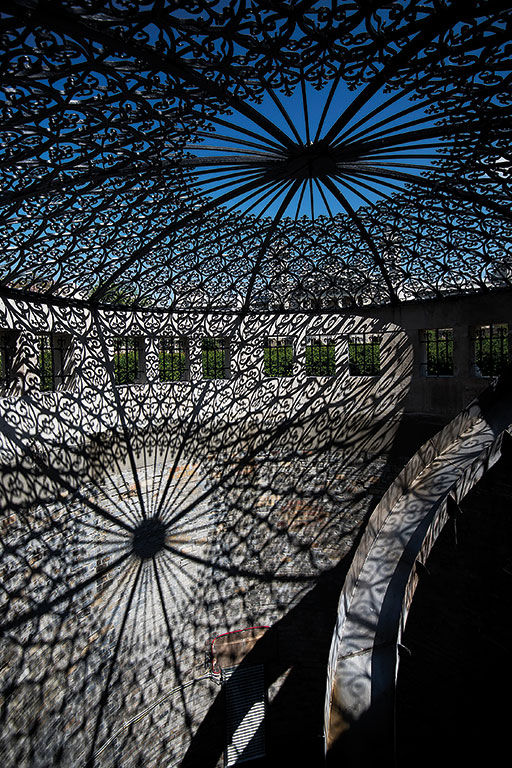
on Kossuth Square (photo: Tamás Wachsler)
While this year’s MITEM was underway, one could see en route the Nemzeti (National) day by day how the stone carvers built the pedestal of the equestrian statue of Gyula Andrássy, the first minister of foreign affairs during the Austro-Hungarian Monarchy, on the concrete core which had been lying there lonely and undisturbed for months. This was theatre, too, right next to the Houses of Parliament, even if the erection of this statue did not generate such media coverage as the transposition of the one of Attila József, which, despite the opposition of certain leading intellectuals, came out successful with the poet gaining a better view from the new place at the Danube of that particular melon-rind floating by…
But before MITEM started, Attila Vidnyánszky was summoned by the director of the Burgtheater at a Goethe Institute panel to give account of the situation of democracy, or rather the lack of it, in Hungary.[1] However, Zoltán Imre, reportedly today’s best authority on the history of national theatres, failed to prove as good a mediator between the two nations as was Count Andrássy in his time, who, after the 1849 bloodshed, turned the Bavarian Duchess Sisi and, through her, even the emperor in favour of Hungarians. Had he answered moderator Beatrix Kricsfalussy’s question about the creation and role in our history of the first permanent Hungarian-language stone theatre, founded in Pest in 1837 and predecessor to the present National Theatre, words would probably not have run high and no scandal would have broken out after the Burgtheater’s performance of The Seagull, either. Fortunately, the atmosphere at MITEM was not determined by this undeserving episode (even if the press was more preoccupied with it than with substantive reviews of the productions).
We must admit that Szcenárium had no intention to rehash the issue this year. Especially as last year we devoted a two-day professional programme to the topic of identity – sacrality – theatrality, the cornerstone of which could have been, according to our intention, the question of national identity.[2] However, we had to concede that the manner of “the staging of nations” is more relevant now than ever. After twelve years, there is a war again across the border of Hungary. And those arriving from a war zone put things differently and step beyond the usual limits of theatre differently from the dictate of Lehman’s theory of postdramatic theatre.
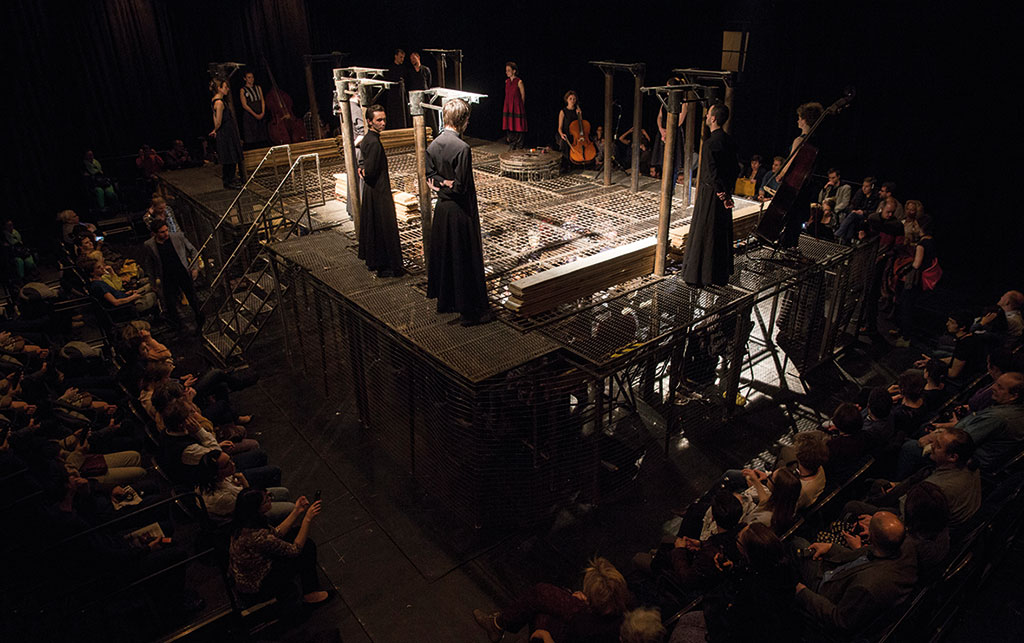
The Kiev DAKH Theatre’s production, Dog’s Cage, is meant to “insult” the audience, at which Hungarian viewers are no longer shocked after fifty years’ experience of alternative theatre. In the first part we observe in apathy the merciless picture of Ukrainian society: the daily routine of amoebic beings vegetating as rats, the drill and cheesy dream world of prison life, reminiscent of soviet times, and fluorescent floral designs. In the second part we realize dispassionately again that now it is time for us to change places with the players and start a dog’s life, letting the sky above us be boarded up. However, when we are called on to sing something that is truly ours, typical of our nation or “tribe”, the play is beginning to take a serious turn: we get the feeling of sitting in a classroom where a most aggressive teacher is examining us and we must not contradict. It took some time until someone broke the silence and started to sing the Hungarian national anthem softly. Almost immediately everyone joined in. At the post-performance discussion, director Vlad Troitskyi reported that in the course of their eleven-stop tour of Western Europe it was the first occasion they managed to make the audience sing. Still, are we allowed to be proud of any such thing after the indoctrination at Goethe Institute? This question was ably answered at the discussion by the confession of a young man in his twenties, who said that the recent experience relieved him of his inhibition which had up till then questioned and made ambiguous his positive relationship to the national anthem and the profession of his national identity.
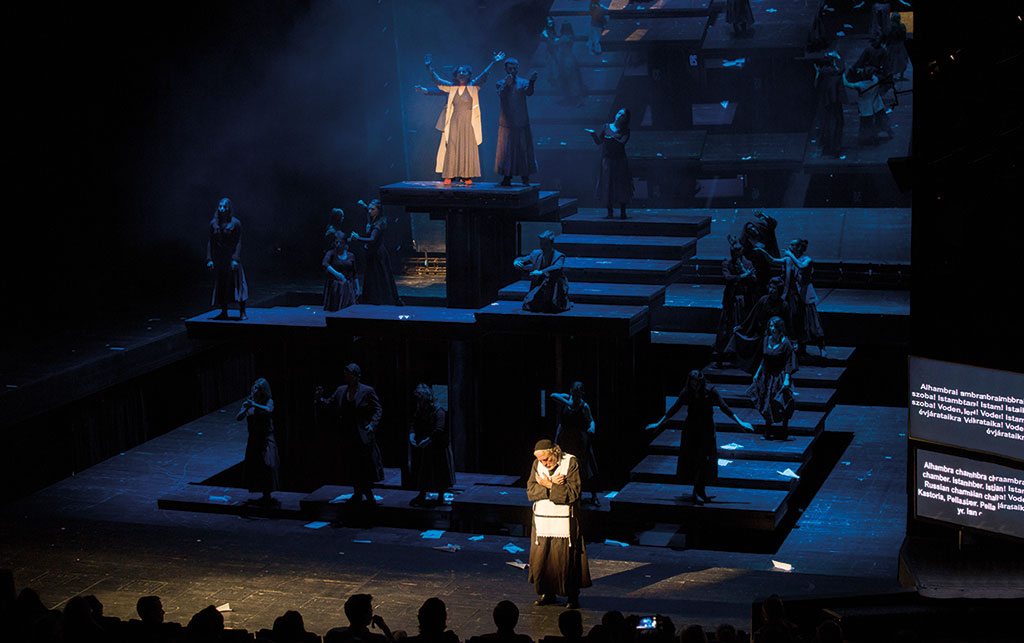
By a happy arrangement, the Macedonian presentation was by two days preceded by the roundtable discussion National Theatres in the 21st Century on 18th April. Stage director Dejan Projkovski, the artistic director of the Macedonian National Theatre, and general manager Dejan Lilic made it known that the greatest cultural enterprise of the barely twenty-year-old Republic of Macedonia had been the construction of a national theatre for all needs, which opened last year. The mega production Eternal House was prepared for the opening ceremony and expressedly demonstrated that “the theatrical concept of nation”, “the staging of the nation”, was not an outdated 19th-century idea, but relevant and existing practice when the current and unavoidable historical task lay in the promotion of a young nation’s consciousness. The director took meticulous care of this “self-representation” to comply with norms of European democracy and not to challenge the sensitivity of minorities living in great numbers in the country. At the same time, he represented on stage the Macedonian heroes of liberty, outstanding artists and scientists of the last one and a half centuries, as those who had been and were still playing a fundamental role in the present-day formation of national identity. It may be open to debate whether the director succeeded in finding a common artistic ground for the private mythology of the protagonist, the old Jewish woman, who is reclaiming the “eternal house” as her rightful property, and for the story of becoming a nation, elevated into cosmic space and time dimensions, where this “eternal house” gains a new symbolic meaning, being open to all who consider themselves part of the nation. However, it is indisputable that this most abstract dramaturgical construction induces audience involvement with the power of sensual evidence through the chorus in Act Two – similarly to the way the prime role is taken by the chorus in the second part of the Ukrainians’ Dog’s Cage production. Not insignificantly, both ensembles use the same archaic music, the roots of which reach back to the drama of antiquity and continue in the tradition of Christian liturgy.
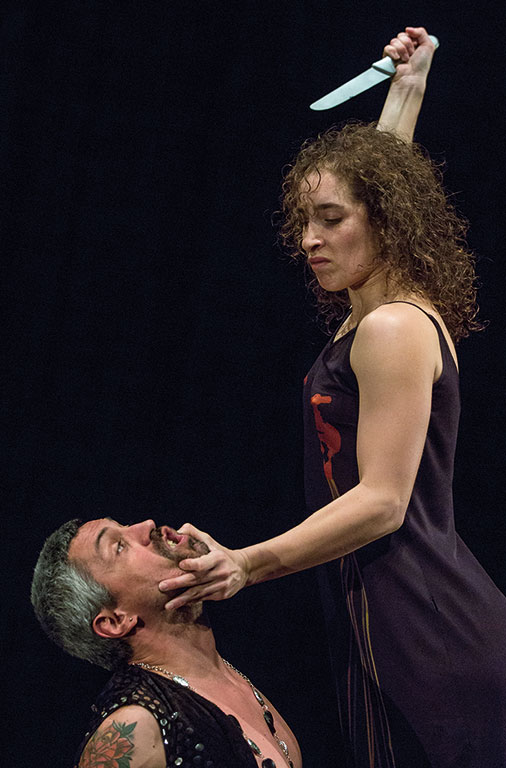
Sud Costa Occidentale, Palermo (photo: Zsolt Eöri Szabó)
Also antique in its theme is the presentation of Sud Costa Occidentale Theatre, Palermo, Italy, Verso Medea, adapted from Euripides and directed by Emma Dante. It is made memorable partly by the reinterpretation of the figure of Medea, with not the murder of the children in its focus but the drama, stemming from differences in culture and civilisation, of a woman who gives birth, against the backdrop of the ethnically and culturally mixed Sicilian population’s multi-layered identity. This is highlighted by the director when she stages Neapolitan and Sicilian dialects beside the standard Italian literary dialect. The Mancuso brothers, whose singing functions as the Greek chorus, also used the Greek and Latin languages. Their throat singing, rich in overtones, first triggered a giggle in the audience, then this special recitative, which primarily served to convey Medea’s internal struggle, soon jerked us into this world of conflicts burdened with elementary passions. Director Imre Katona made the perceptive remark at the post-performance discussion that the choruses in ancient Greek theatres with a capacity of tens of thousands must also have used this technique and had this transmissive power in their time.
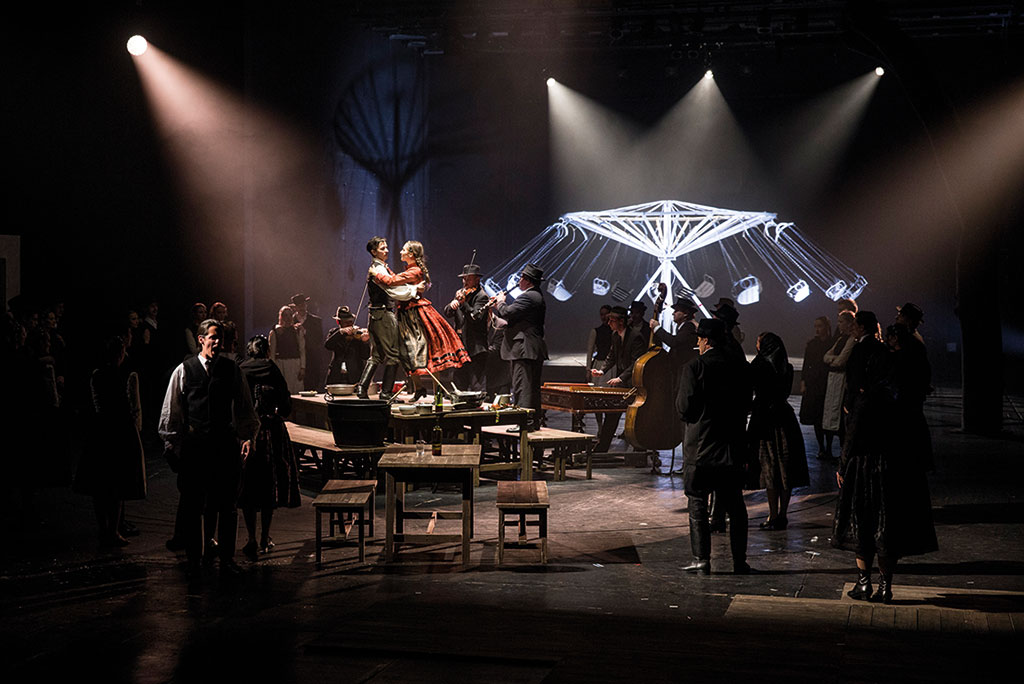
Apart from the above three productions, it was Körhinta (Merry-Go-Round) and Isten ostora (Flagellum Dei) which also had a dominant presence of ethnic tradition in their musical texture. In our view, Merry-Go-Round, directed jointly by Attila Vidnyánszky and Zoltán Zsuráfszky, is pregnant with the chance of such a new genre as reverses former practice: it does not try to have dance tell a necessarily simplistic story but takes a complex epic story as its starting point to create a dance drama which does not illustrate but expands and sensualizes the world in which the plot takes place. In this staging of Merry-Go-Round the communal character, customs and festive rituals of Hungarian rural culture are added to the story and the personal drama of the main characters through folk dance in a virtuoso and genuine way.
As the National Theatre is preparing for a Don Quixote premiere this year, we were very much looking forward to the Teatro de La Abadía production, Entremeses, directed by José Luis Gómez of Cervantes’ comedies. The twenty-year old ensemble seems to be following in the footsteps of Giorgio Strehler, who earned a reputation in the 60s as, among other things, the reformer of commedia dell’arte. This presentation proves to us that traditionalism these days is a possible direction for stage renewal, especially if it is realised at such a level of aesthetic excellence, where superb character acting is coupled with exciting tempo changes, culture of singing and motion. The most distinguishing feature of Cervantes’ poetics of the novel, namely the continuous interplay between the worlds of reality and imagination, was subtly represented on stage, and this was the prime mover of dramaturgy and main source of humour in the stories abundant in comic situations. If we come to think of the exceptional moment in Hungarian theatre history when József Ruszt directed Csokonai’s Karnyóné (The Widow of Mr Karnyó) on the Egyetemi Színpad (University Stage) in the 60s and also drew an international response, we can only feel sorry for the failure of this kind of full-blooded theatricality of comedy-playing and “folk culture of laughter” to gain ground here at professional theatres over the last decades.
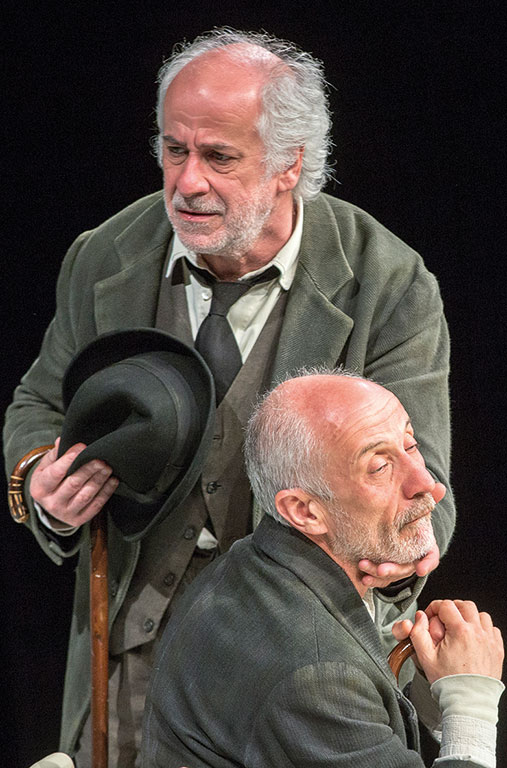
Teatré Uniti di Napoli, d: Toni Servillo (photo: Zsolt Eöri Szabó)
It is also the several centuries’ culture of playing commedia dell’arte that the absurd comedy entitled Inner Voices, played in the Neapolitan dialect, originates from. Its author, Eduardo de Filippo (1900 – 1984), who came from a famous acting dynasty and is called the Italian Moliére, has recently been ranked with Beckett, Ionescó or Pinter. The play, written after World War II in 1948, and directed by as well as starring Toni Servillo, arrived at MITEM within the framework of a major European tour just to bring down the house. It showed that the kind of irrationality which distinguished Italian society at the time of the play has, by now, become a constant condition of the world and that the characters in the drama very much resemble the modern type of man, who cannot and/or would not tell the difference between the worlds of virtuality and reality, especially if it suits his interest not to do so.
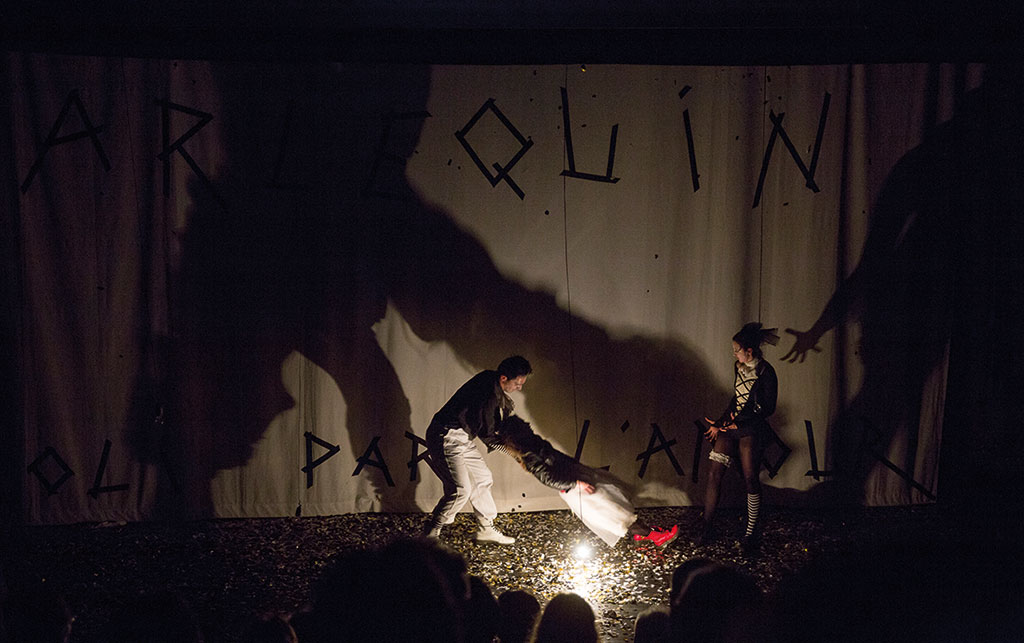
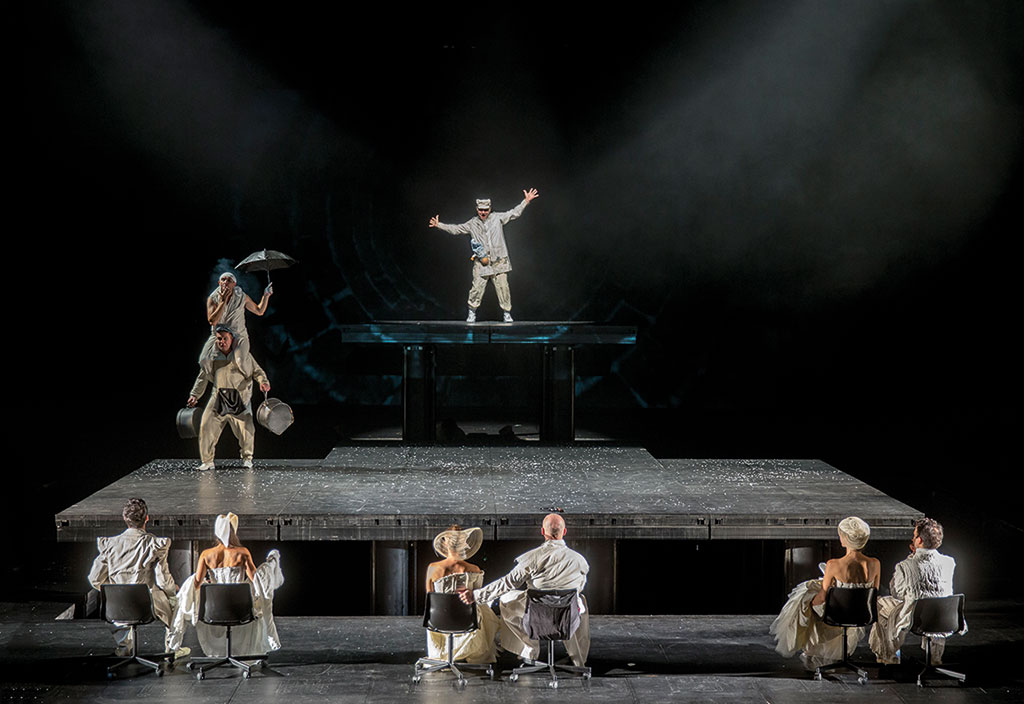
At the post-performance discussion we learnt from Thomas Jolly, the young French director, that the present staging of Harlequin, Refined by Love was already the third version of the original, which he created seven years ago, right after his graduation from the theatre academy, and which he meant as an act of rebellion against contemporary postdramatic theatre. That is why he turned towards 18th century author Pierre de Marivaux, himself a rebel in his time, challenging the supremacy of Italian comedians as a French playwright. Beyond the so-called “French ease” which describes every bit of this performance, the secret of its success presumably lies in the viewers’ pleasure to see these talented young people apparently having a good time and also in being made to believe them that they have something to say about love, which, let us admit, is one of the toughest subjects to be staged nowadays (it is enough to think of A Midsummer Night’s Dream directed by David Doiashvili[3] or Rózewicz’s White Marriage at MITEM). From time to time, attention needs to be drawn to the fact that the language of love is to be acquired, too, and that theatre is a most effective medium for that, particularly when it is young people who pass on the vocabulary of this language from the stage to other young people. It is worth it, even if the idyllic scene, which seemed to be lasting for ever in the moment of finding each other, turns dark at the end of Jolly’s latest staging and the protagonist sacrifices love at the altar of struggle for power.
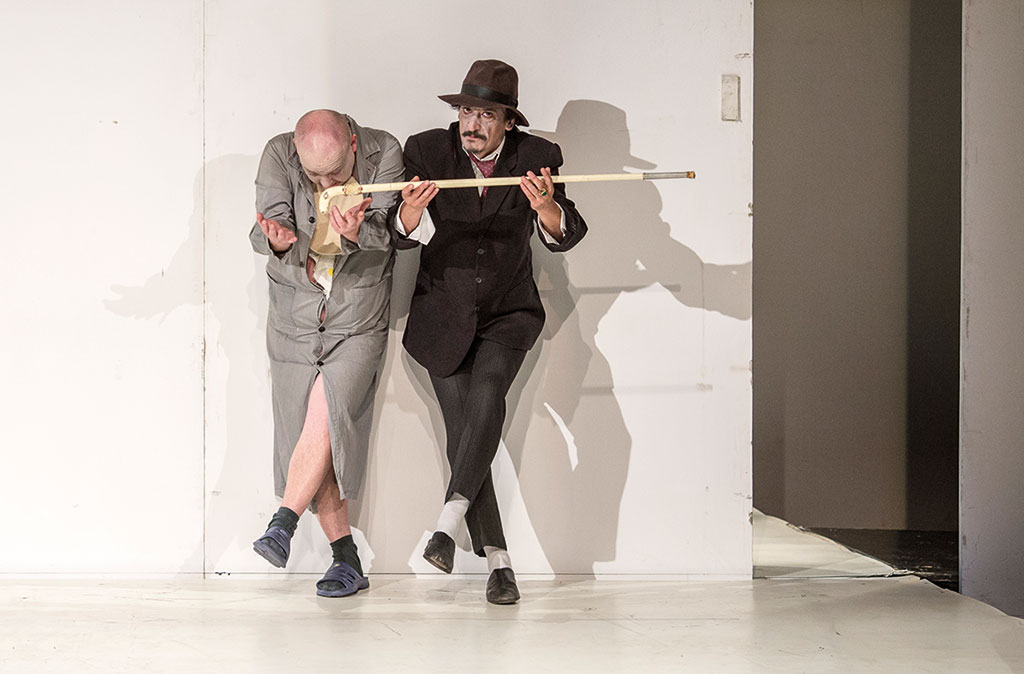
It may well be that it was the last time we could see Tibor Pálffy at MITEM in the lead of The Miser, at present Molière’s most frequently played piece in Hungary, since the play will be removed from the programme of the Sepsiszentgyörgy theatre. It is a pity, since he has been one of the best – if not the best – Harpagons on the Hungarian stage over the last three decades. In addition to the actor’s ingenuity, the secret of roaring success is to be found in director László Bocsárdi’s interpretation of the work, which instead of making the protagonist a subject of ridicule gradually uncovered the much-to-be-pitied and lovable man in him. It again proves to us indirectly that the genre congenial to Hungarian humour is not annihilating satire. In this case we saw a tragicomedy with ageing, and not money in its focus. This is expressed clearly by Harpagon’s nudity, which makes him as fallible as a newborn. This ambiguous tone seems to be best suited to Transylvanian, or more precisely Székely mentality, too, which is perfectly compatible with the unbroken tradition there of character acting. It is a shame that the “main stream” in Hungary does not prefer this style and dismisses it as outdated.
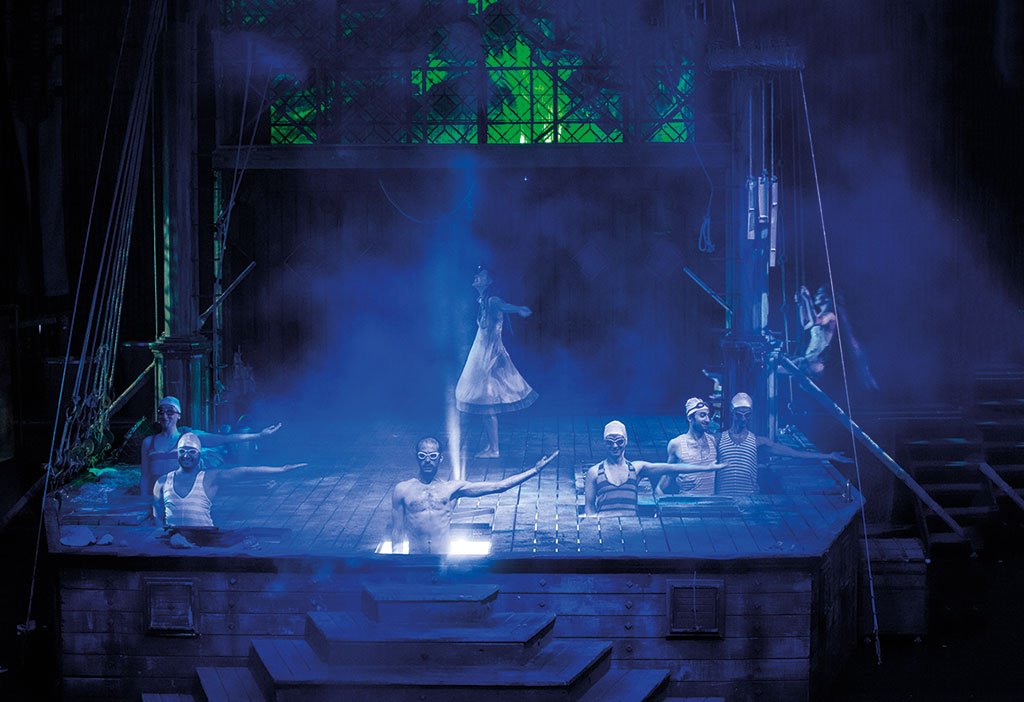
The comic vein of Romanian theatre was exposed by the Shakespeare production of the Bucharest National Theatre, The Tempest, directed by Alexander Morfov. He said that he was inspired to reconstruct the Elizabethan stage by the exceptional facilities of the renewed Romanian National Theatre. Scenography of this kind is thoroughly suitable to increase the intimacy of acting and to relieve the presentation of computer-controlled technical effects and allow actors to move props, like for example at the evocation of the storm. This aspect of animation apparently follows from the director’s grounding in puppetry, too, but is not alien from Romanian theatre in general, either. Morfov belongs to the rare exceptions of directors who have a feel for the stage representation of eroticism and love (cf. the shipwreck episode in Don Juan at last year’s MITEM[4]). Here, the scenes with the couple Miranda and Ferdinand remain in the memory, even if their story is not allowed a happy end by the present staging, either. Morfov’s sceptic statement at the post-performance discussion on the general crisis of theatre and his fear of the pleasure of play vanishing at once from people’s lives and the stage was also thought-provoking.
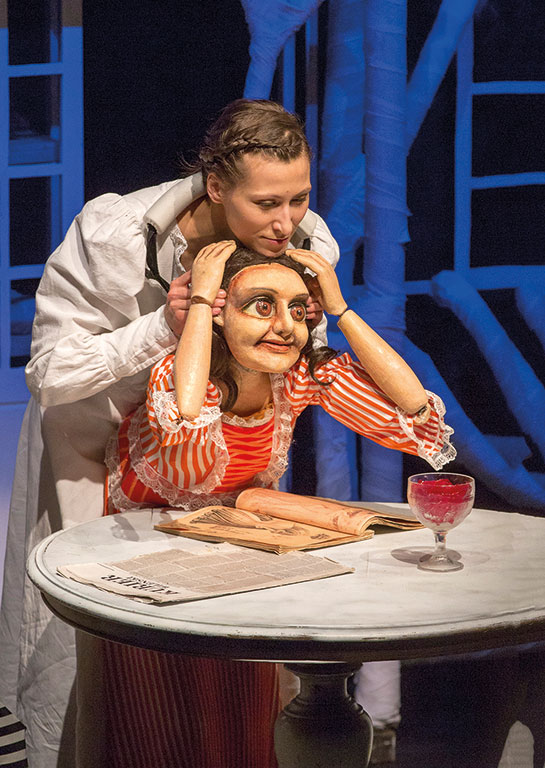
d: Oleg Żiugżda (photo: Zsolt Eöri Szabó)
After a survey of the above nine productions, two aspects emerged as bases for classification and drawing parallels, namely the manner in which nation is represented on stage as well as the adherence to traditional acting. Now we continue by three presentations which used puppets, or may unequivocally be qualified as puppet theatre. The staging of Rózewicz’s drama White Marriage (1973) is an authentic puppet theatre production, even if some critics, ignorant of this genre’s aesthetics and mechanism of action, are embarrassed when they see a puppet and a human actor side by side on the stage, especially in this case when the topic is love, corporeality and morals. This piece is described by theatre history as melodrama and low comedy combined. It was just this contrast of genres which made the idea of a transcript for puppets a good one, because a puppet is far more adequate than a human actor for the suggestive visualisation and clashing of these generic extremes, let alone the undisguised representation of sexual intercourse. At the time when the play was written, the author’s dominant intention must have been social criticism, however, in our time, when prudery and pornography mix to form an unprecedented symbiosis, the presentation raises the question at the level of anthropology whether corporeality and love have any chance in our life to be synchronised. The puppet theatre is capable of expressing and making fun of this civilisational fake-conflict – which nevertheless is, as it was in the past, taking its deadly toll – and by this it is already capable of healing, too. It is initiatory theatre par excellence, relieving spasms of anxiety, addressing us all, and of vital importance to adolescents primarily, when they first face the brutal force of sex.
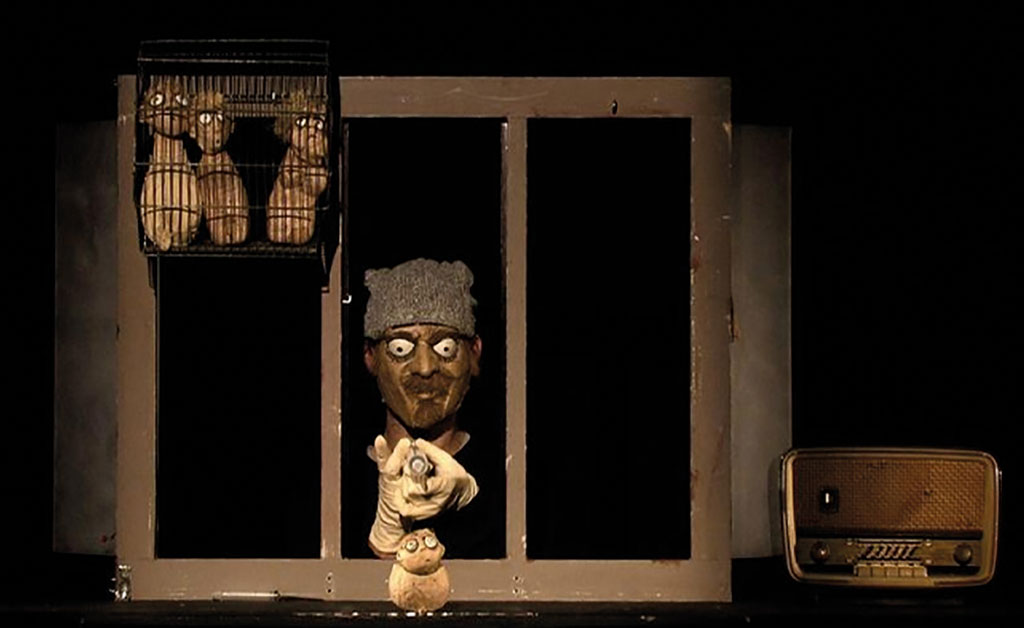
In the 70s of the last century, European puppetry discovered how to represent daemons, ready to break out into the open, in the subconscious of modern man. This tendency, made to triumph by the Dutch Figurentheater Triangel as well as the English Stephen Mottram, well known also in Hungary, has become the one and only among Western-European puppet theatres playing for adults. However, while these particular daemons were – at least in the beginning – embodied by amorphous imaginary creatures there, Éric Déniaud has human-shaped miniature beings play the almost-stories and monologues of Matei Vișniec’s poetic texts on urban loneliness. A major element in the mechanism of action is that while viewers need to focus on under-illuminated and hardly visible images, the text itself becomes extraordinarily intensive, somewhat similarly to the classical shadow play which makes the direct projection of happenings in the soul possible. Having seen the presentation, a question arose in our mind about why this school has not taken root in Hungary, where poetic and dramatic texts requiring this kind of representation are written in increasing numbers these days.
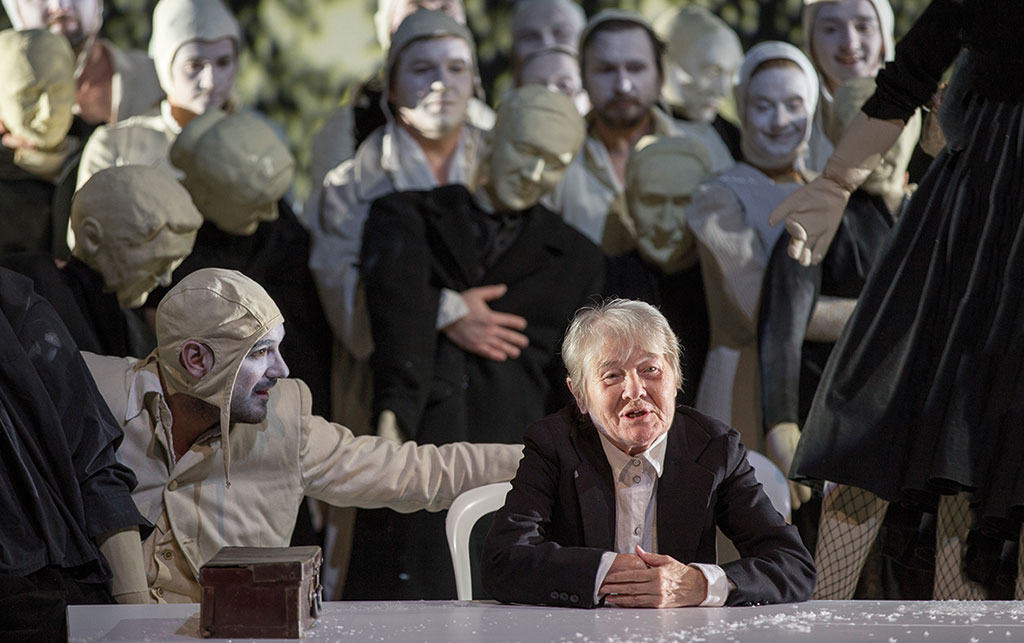
The way director Viktor Ryzhakov stages the puppet in A Night’s Lodging is of an absolutely different kind. Ryzhakov, similarly to Tadeusz Kantor, presents life-size mannequins on stage as duplicates of marginalised individuals. Though this solution here does not carry the sort of symbolic meaning as with Kantor. The actors drag along their duplicates as some ballast in order to illustrate that the players cannot get rid of their burden, whether this forced symbiosis be interpreted as a mental or a physical weight. Still, the animation projected onto the ever-changing, abstract setting creates such an exciting psycho-space, never seen before on Hungarian stage, as throws entirely fresh light upon Gorky’s play.
Having seen these three puppet performances, we welcome the genre’s long-awaited coming of age at this year’s MITEM anyway.
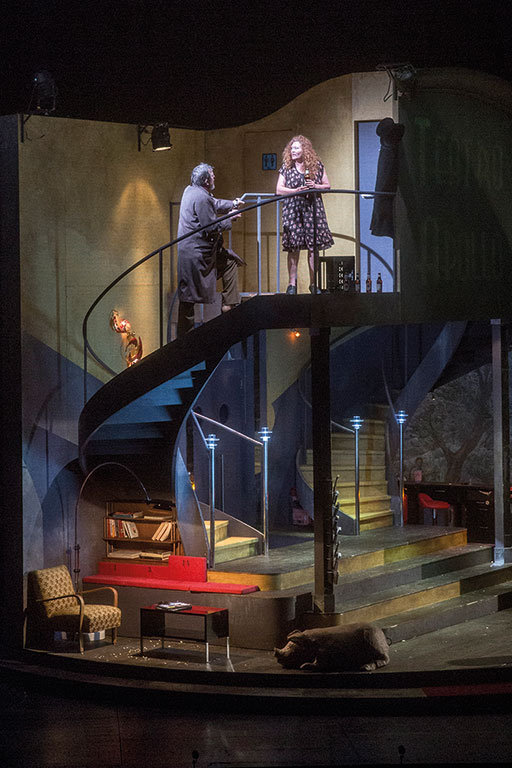
d: Matthias Langhoff – Caspar Langhoff (photo: Zsolt Eöri Szabó)
No one can say that the so-called postdramatic school has been underrepresented at this festival. Three of the productions were undoubtedly typical examples of this “main stream”: Cinéma Apollo, The Brothers Karamazov and The Seagull, directed by such famous European artists as Matthias and Caspar Langhoff, Luk Perceval and Jan Bosse, respectively. Although this idea of ours would not be easy to support in an exact manner, because even those aesthetes evade the accurate definition of the concept of postdramatic theatre who introduced the term by the inspiration of Hans-Thies Lehmann in the last year of the 20th century and have been propagating it, like Patris Pavis, ever since. It is almost unique in Hungarian theatre history that Lehmann’s work came out in Hungarian as early as one year after its publication, in 2000[5], and that a new school of theatre theory sprang from it, aspiring to exclusivity by now. It is easy to see that the adjective ‘postdramatic’, like ‘postmodern’, denotes not only an aesthetic category but also a general state of the world, referring, at the end of the day, to the unfeasibility of man as a dramatic being, incapable of active participation in their own life. However, we in East-Central Europe, where exposure to the constellation of world politics has been present for centuries, are coping with this traumatic condition in a completely different manner from that of the citizens and artists in Western realms. Yet it is now observable that as a consequence of the world crisis, which did not spare affluent societies, either, and existential exposure, a feeling of responsibility and a need for practising active citizenship are arising in our Western-European colleagues, too. It was not only Vlad Troitskyi at MITEM who stressed that it is time to stop pointing fingers at one another and take personal responsibility for what is happening to and around us, but also François Chattot, protagonist of Cinéma Apollo, who, already over sixty, even founded a new company called “Service Public” in that spirit in 2013[6].
The above was put forward because we ourselves do not quite comprehend why we were not overwhelmingly impressed with these presentations heralded as superproductions. The parade of the multimedia inventory in Cinéma Apollo, directed by the two Langhoffs, father and son, was certainly compelling. Our attention was also caught by the fake documentary film extract in the first part and we would not say that the autobiographically inspired story on 20th century man’s experience of displacedness was of no interest, either. However, the ultimate suggestion of the production was that we, like the protagonist, are left outside of our life, therefore, unlike Odyssey, we have nowhere to return. We took home the depressing feeling that the performance had too much text and that the outburst of emotion by the protagonist’s casual chat partner, the female employee at the cinema, on account of her bitterness over her unlived life could be nothing but a belated reaction to the story she had been listening to, in fact an unnarratable one.
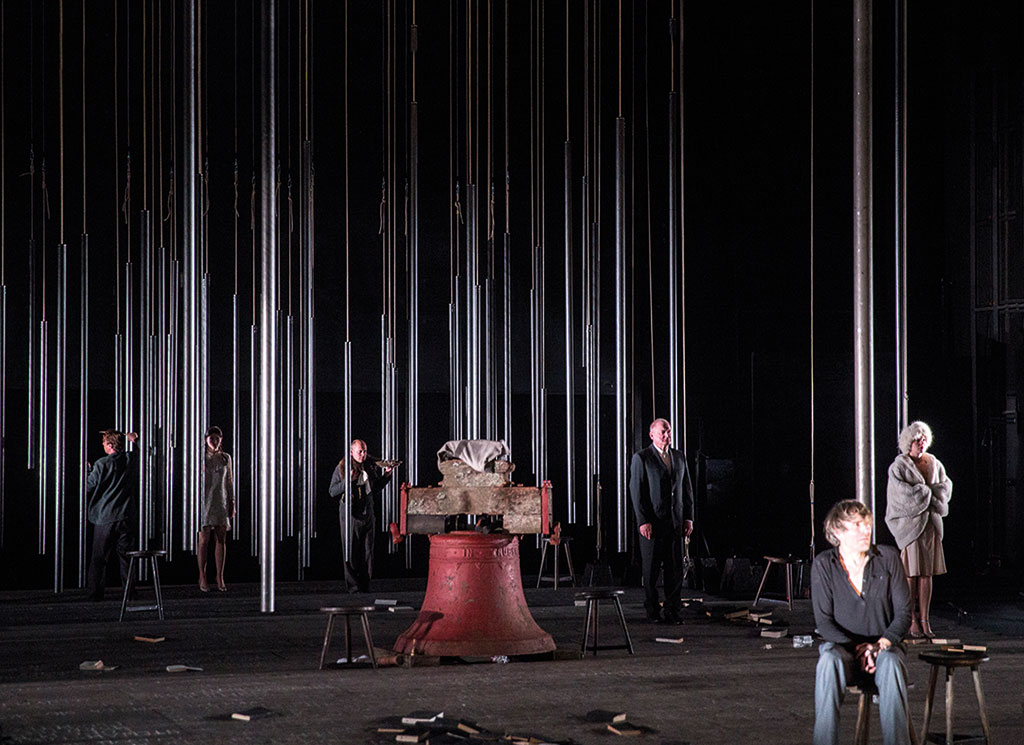
The other two productions, contrary to that of Matthias and Caspar Langhoff, were not author-oriented – Luk Perceval and Jan Bosse put a novel and a drama by the two best-known Russian classic writers, Dostoevsky and Chekhov, on stage, inviting us to pose the question whether the primary criterion of postdramatic theatre, the new attitude toward the literary material, has been done justice to. The Brothers Karamazov is by no accident termed a novel-tragedy, which depicts the relationship between the possible perpetrators of the patricide at an existential, psychological and intellectual level simultaneously. Apparently the director shows little interest in this complexity, and, instead, is dealing directly with spirituality, the nature, presence or lack of faith in god. This simplification does not serve the play well. Perhaps this is why even viewers familiar with the novel find it difficult to identify the two brothers: Alyosha, who entered a monastery, and Ivan, the poet-philosopher brooding over the ultimate questions of faith. Although Mitya, who lives his own faith sensuously, is unmistakably recognised from the start (if for no other reason, because he is the only active figure in the presentation), his true inner drama will never come to light in this directorial concept. If Grushenka (played brilliantly by Polish-born Patrycia Ziolkowska) did not appear on stage, this performance would hardly amount to more than a Readers Theatre using high-standard scenery and excellent acting.
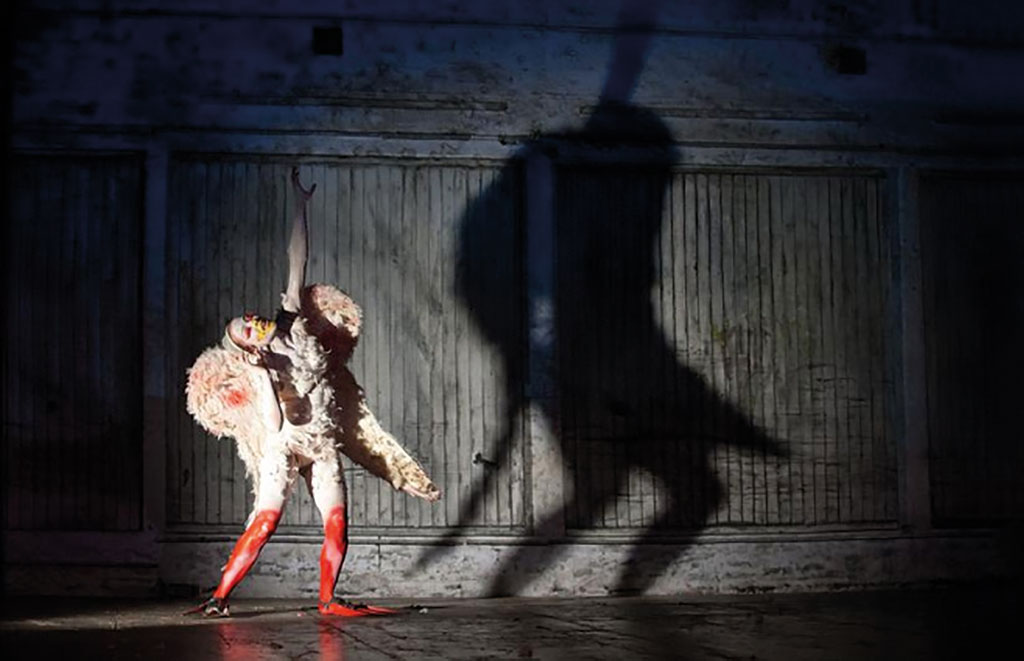
The Seagull, presented by Burgtheater, made us declare again that Chekhov is a great author. We may firmly state this also because the director felt no need to change the structure and plot of the drama or to trim its text. Still, the postdramatic character of the direction is to be caught in the interaction with the audience provoked by the actors at the beginning of the performance and in the appearance in Scene One of the actress in Nina’s role (Aenne Schwarcz) as a sort of waterfowl, funny and lovable at the same time. It is a shame that this kind of playfulness and affinity for caricature does not permeate the entire direction. Although there are a couple of ideas throughout the production which resemble the symbolic language of the first scene (e.g. the photo-animation, the scene of lonely Treplev playing the guitar), the further devices do not much differ from the psycho-realistic clichés of conventional theatre.
Three more presentations at the festival might as well be classified – on account of certain formal features – as belonging to the same postdramatic trend: Faulkner.Silence, Brand and Flagellum Dei.
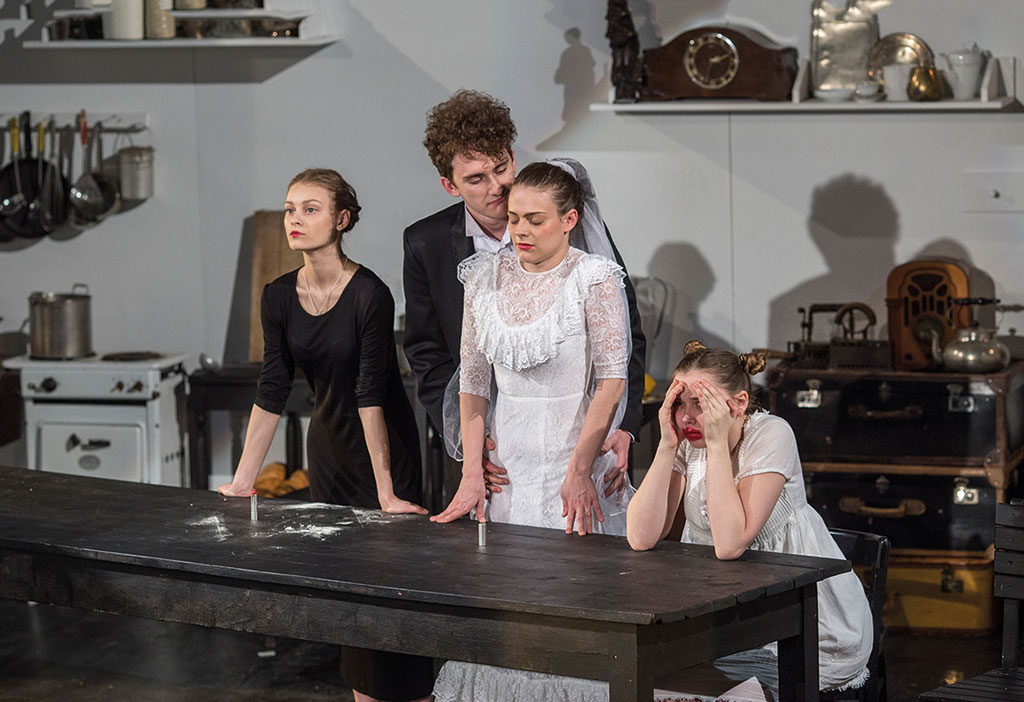
The exam performance Faulkner.Silence, directed by Viktor Ryzhakov, prides itself on the same virtues with regard to play as Gogol.revizor last year. The spirit of this school is distinct from contemporary Western aspirations primarily in that the deconstruction of the selected literary material is realised through the array of devices of the Russian avant-garde, above all the reform of the language of theatre associated with Meyerhold’s name. It is characterised by using etudes for construction, harshness and dynamism, extreme caricature in playing style, which puts psychologism into the shade and gives priority to team work rather than brilliant individual acting. These devices were functioning perfectly during last year’s performance, but, in our view, failed to do so this year. It is not easy to explain why. It is perhaps because Gogol’s satire is a seminal work of Russian national identity and, as such, the director and the young team found it fitting from the outset. Now they have undertaken the stage adaptation of an already unconventional Western novel, which could, in theory, have been suitable for another successful presentation, but, as we see it, this company, however hard it tried, eventually failed to relate to the selected work, or its foreign social context, as its own.
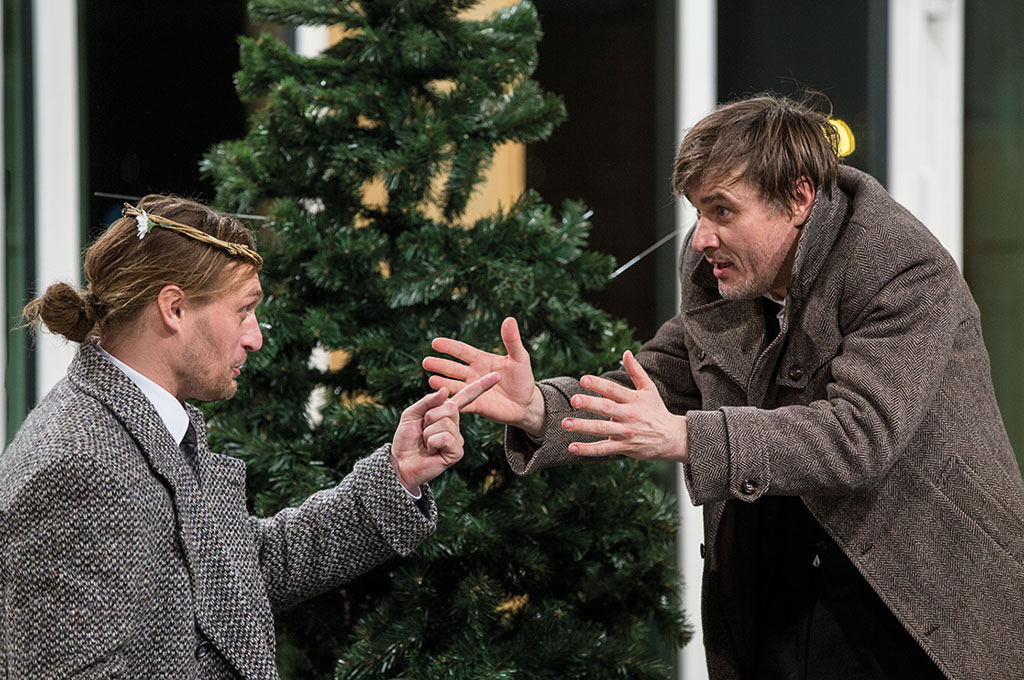
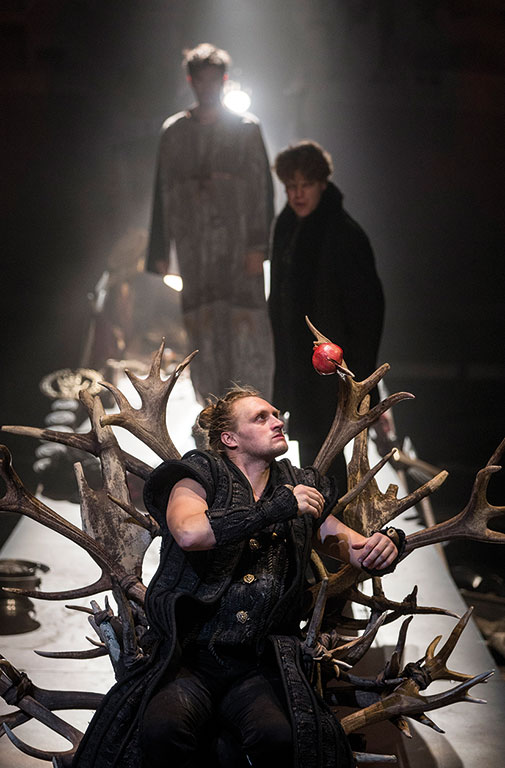
d: Attila Vidnyánszky (photo: Zsolt Eöri Szabó)
Brand, directed by Sándor Zsótér, and Flagellum Dei, directed by Attila Vidnyánszky, share one thing in common: the focus of the selected works and the presentations is a dramatic hero in the classical sense of the word. This is paramount in both enterprises even if both directors happen to deconstruct and revise the narrative structure of the initial work, which is a standard postdramatic procedure. Brand is a romantic hero, Attila is one of myth and legend – neither is to be gauged by any ordinary measure. Their brand of solitude is distinct from that of postdramatic works’ characters’, who feel extruded even from their very life. The heroes of these two presentations are eager and able to do something not only for themselves but for others as well. They are entrusted with responsibility for a larger community, or even have to decide the fate of an entire nation or empire. It is not true that these two stagings were created out of some gazing into the nostalgic past. What we see on stage is exciting because it puts into circulation the heritage of European dramatic literature, the heroes of 19th century late-Romanticism and 20th century Art Nouveau, by stripping them of the conventional array of devices which were attached to their former stage representations in the viewer’s consciousness. We believe we can safely call these two productions Neo-romantic, but it is not our duty to decide here whether this kind of Neo-romantic vision is a phenomenon inside or outside the postdramatic canon.
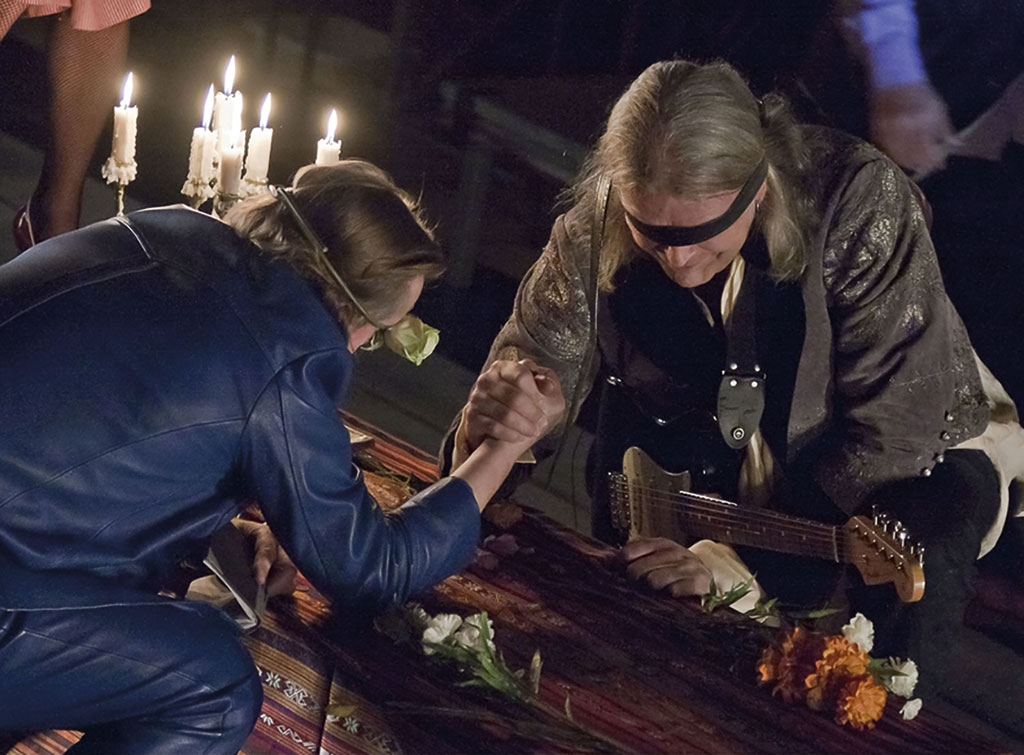
On 11th April, at the presentation of the book “Land of Ashes and Diamonds”[7], we rose and observed a minute’s silence in memory of Judith Malina, co-founder of the American Living Theater. Theatre historians now consider this experimental company, founded in New York in 1947, as a forerunner of postdramatic theatre. Interestingly enough, Odin Teatret, created by Eugenio Barba in 1964, is not to be found in the Wikipedia list, although it could rightly be there. But what is most interesting is that this fifty-year old theatre workshop represents such a unique profile and operating model on the world’s contemporary theatrical palette as rooted in the autonomy of the actor and equal partnership throughout the creative process leading to a performance. The Chronic Life presented at MITEM is also an imprint of this kind of operation, with the actors not shaping roles in the classical sense but each of them singing a part, embodying characters they themselves have created and elaborated, who may also be regarded as the iconised figures of a generation – the so-called “great generation”. The coffin placed in the middle of the playing area, as a sacrificial altar, and the ritual taking place around it may be interpreted as a singular funeral observance, suggesting that we have irrevocably arrived at the end of an era. After the playing area has been surrounded by terrorists, the characters have no other choice but, with that particular key they possess as artists, escape from it.
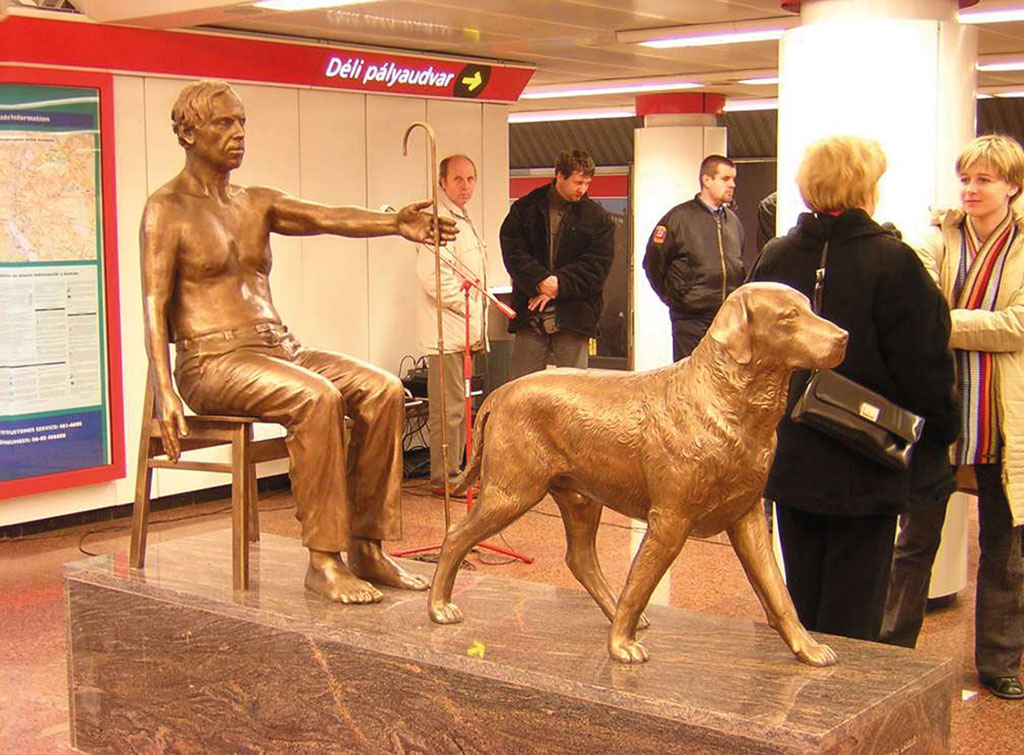
Which way next? At the metro station in Kossuth square, where we pass by weekly, everything looks just the same for the time being: Tiresias’ postmodern doggy sculpture is offering his friendly left hand to shake, pointing in the direction of the escalator, which is moving upwards from the “underworld”…
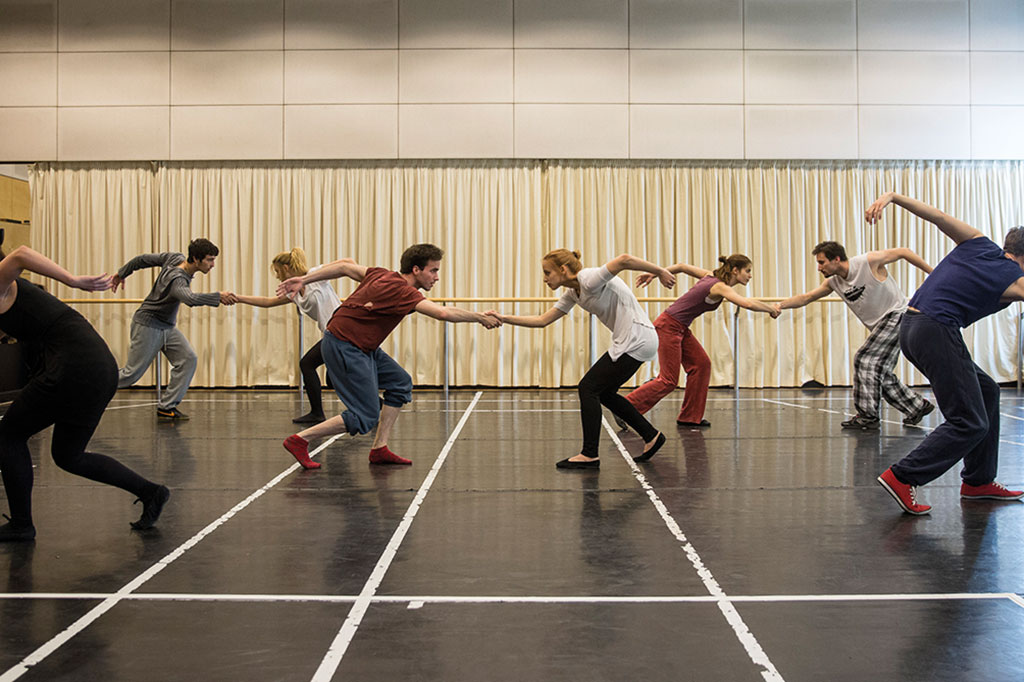
Zsolt Szász – Ágnes Pálfi: Friendly Hand-Shakes?
A Flash Report on Recent MITEM Presentations
The two editors of Szcenárium first reflect on the shaky roundtable, initiated by the Burgtheater, at Goethe Intézet (Goethe Institute) before MITEM, then on the incident following the company’s performance of The Seagull, adding that the atmosphere of the festival was fortunately not determined by these undeserving episodes. They continue by a survey and assessment of the festival presentations structured according to the following points: the thematization of national identity (Dog’s Cage, directed by Vlad Troitskyi; Eternal House directed by Dejan Projkovski); adherence to traditional acting (Entremeses,directed by José Luis Gómez; Verso Medea, directed by Emma Dante; Inner Voices, directed by Toni Servillo; Harlequin, Refined by Love, directed by Thomas Jolly; The Miser, directed by László Bocsárdi; The Tempest, directed by Alekszandr Morfov; Körhinta (Merry-Go-Round), directed by Attila Vidnyánszky); headway of puppetrical approach (White Marriage, directed by Oleg Żiugżda; Voices in the Dark, directed by Éric Déniaud; A Night’s Lodging, directed by Viktor Ryzhakov); types of aspirations to postdramatic theatre (Cinéma Apollo, directed by Matthias Langhoff and Caspar Langhoff; The Brothers Karamazov, directed by Luk Perceval; The Seagull directed by Jan Bosse; Faulkner. Silence, directed by Viktor Ryzhakov). Within the latter they group Brand (directed by Sándor Zsótér) and Flagellum Dei (directed by Attila Vidnyánszky) with the neo-romantic movement on account of putting on a hero in the classic sense. Appraising The Chronic Life (directed by Eugenio Barba), they underline that the now fifty-year old Odin Theatre has, from the beginning, represented a creed which looks upon the autonomy of the actor as the starting point for artistic work in partnership. The editors also give voice to their opinion that it is presentations thematizing national identity and renewing traditional acting which have become most memorable at this year’s festival and that the headway of puppetrical approach indicates the genre’s coming of age.
[1] The event took place on 13th April, 2015. Its participants from abroad were Karin Bergmann, director of the Burgtheater, Joachim Lux, director of Thalia Theater, Hamburg, and Matthias Langhoff of Theater Vidy-Lausanne.
[2] Papers related to the professional programme were published in the March, April and May issues of Szcenárium.
[3] Márta Tömöry gave an analysis, entitled A befogadó fantáziaképei (The Recipient’s Images) of the play at the Nemzeti Színház as well as the above-mentioned direction. See the 2014 issue of Szcenárium, pp 55-64.)
[4] Of the topic and direction see Ágnes Pálfi: Don Juan minden időben (Don Juan Through Changing Times) in May 2014, Szcenárium, pp 37–52.
[5] Hans-Thies Lehmann: Postdramatisches Theater. Verlag der Autoren, Frankfurt am Main, 1999. In Hungarian: Hans-Thies Lehmann: Posztdramatikus színház, Balassi Kiadó, Budapest, 2009.
[6] Actors’ existential crisis and the situation of an acting career in the changing world were the topics in focus at one of the MITEM professional programmes, entitled One Generation, Two Countries, Three Emblematic Actors, on 15th April. The roundtable was moderated by Jean Pierre Thibaudat, and had Évelyne Didi, Dorottya Udvaros and François Chattot as participants.
[7] The presentation of Eugenio Barba’s book was a pre-event to MITEM, with the author’s participation and Julia Varley’s presentation.
(09 December 2022)

